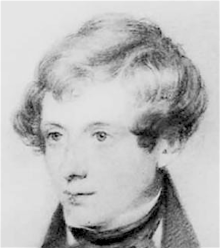
Henry Roberts was born to British parents in Philadelphia, Pennsylvania on 26 April 1803. Soon after his birth he moved with his parents to England. In 1817 he was articled to Charles Fowler (1792-1867) in London and remained as his assistant until 1825. He then worked as an assistant in the office of Sir Robert Smirke (1780-1867) in London and assisted him in his drawings for the British Museum. He also attended the Royal Academy Schools in London. In 1828-29 he spent a period travelling in Italy.
Following his return to England Roberts commenced independent practice as an architect in London in 1830 with an office at 23 Suffolk Street. He had immediate success by winning the competition to design the Hall for the The Worshipful Company of Fishmongers of the City of London in 1831 (built 1832-35). Numerous commissions followed. These included Camberwell Collegiate School in Camberwell, Surrey [now London] (1834-35); the Destitute Sailors' Asylum in Whitechapel, London (1835); The Glebe House, Southborough, Kent (1836); Escot House in Talaton, near Ottery St Mary in Devon (1837-38) for Sir John Kennaway; Presbyterian Chapel, Grosvenor Square, Manchester (1838); Escot Chapel in Talaton, near Ottery St Mary in Devon (1839-40) for Sir John Kennaway; Norton Manor in Norton Fitzwarren, Somerset (1843); St. Paul's Church for Seamen, in Dock Street, Whitechapel, London (1846); St, Peter's Parsonage, Norbiton, Surrey (1846-47); enlargement of National Scotch Church, Crown Court, Covent Garden, London (1848); National School, Norbiton, Surrey (1851); Wigtown Parish Church in Bank Street, Wigtown, Wigtownshire, Scotland (1851); and St. Matthew's Church, Nottingham (1853-54).
From early in his career he was interested in the provision of well-designed and humane working-class housing and in 1844 was appointed Honorary Architect to the Society for Improving the Condition of the Labouring Classes (SICLC), and was subsequently Vice-President of the Society. On behalf of the Society he designed housing in Lower Road, Pentonville, London (1844), and Model Dwellings on Streatham Street, Bloomsbury London (1848-51). Many houses and cottages based on plans designed by Roberts for the SICLC were also built throughout Britain. "In these works he laid the foundations for later experiments such as those at Port Sunlight, Bournville and Letchworth Garden City " [James Stevens Curl. Oxford Dictionary of Architecture. 3rd edition, 2015 p. 640]
Roberts also wrote extensively on working-class housing. His books included The Dwellings of the Labouring Classes, their arrangement and construction, illustrated by a reference to the model houses of the Society for improving the condition of the labouring classes (1850, 6th revised edition, 1867); Home reform: or, what the working classes may do to improve their dwellings (1852); Healthy Dwellings and Sanitary Defects in the Homes of the Working Classes (1861); and The Physical Condition of the Labouring Classes, Resulting from the State of their Dwellings (1866). He also advised on housing schemes in The Hague, St Petersburg and Brussels
In 1844 Roberts took up an appointment as architect to the joint companies responsible for building the Brighton, Croydon, Dover and Greenwich Railway, and with Lewis Cubitt (1799-1883) and John Urpeth Rastrick (1780-1856) was engaged on the design the rebuilding of London Bridge Railway Station.
Roberts was elected a Fellow of the Royal Institute of British Architects (FRIBA) in 1837. George Gilbert Scott (1811-1876) worked in Roberts' office from 1832 to 1834 and described him as "a gentlemanly, religious, precise and quiet man" [Colvin p. 872].
In 1849 Roberts patented an invention of cheap, light, well-insulated hollow bricks.
For family reasons Roberts moved to Italy in 1853. He died at his home in Italy, the Villa Romana, via Senese, Florence, on 9 March 1876. For family reasons Roberts moved to Italy in 1853. He died at his home, the Villa Romana, via Senese, Florence, on 9 March 1876. He was initially buried in the Cimitero degli Inglesi in Florence, but reinterred in the Cimitero Evangelico degli Allori, via Senese in Florence in about 1880.
See:
British Listed Buildings - 42 listed buildings by Henry Roberts
Histiric England - 51 entries on Henry Roberts
Colvin, Howard, A Biographical Dictionary of British Architects 1600-1840. New Haven, Connecticut and London: Yale University Press, 4th edition, 2008 pp. 872-87
Curl, James Stevens. ‘Henry Roberts (1803-76) architect and housing reformer: Evangelical, family, and other connections’ in The Practice of architecture : eight architects, 1830-1930. Edited by Christopher Webster. Reading : Spire, 2012 pp. 14-47
Curl, James Stevens. The Life and Work of Henry Roberts (1803-76), Architect: The Evangelical Conscience and the Campaign for Model Housing and Healthy Nations. Chichester: Phillimore & Co. Ltd., 1983
Curl, James Stevens. Oxford Dictionary of Architecture. Oxford: Oxford University Press, 3rd edition 2015 pp. 64-641
Directory of British Architects 1834-1914. Compiled by Antonia Brodie, et al. Volume 2: L-Z. London; New York: British Architectural Library, Royal Institute of British Architects/Continuum, 2001
Dixon, Roger. ‘Henry Roberts’ in Macmillan Encyclopedia of Architects. Volume 3. Edited by Adolf K. Plakzek. New York and London: Macmillan and Free Press, 1982 pp. 589-590
‘Obituary’. RIBA Proceedings 1875-76 pp. 1, 39
Tarn, John Nelson Five per cent Philanthropy. Cambridge; Cambridge: Univ. Pr. 1973 [An account of housing in urban areas between 1840 and 1914]
Watson, Isobel. ‘Five per cent philanthropy: model houses for the working classes in Victorian Camden’. Camden History Review no. 9, 1981 pp. 4-9 [Housing schemes designed by Henry Roberts and others]